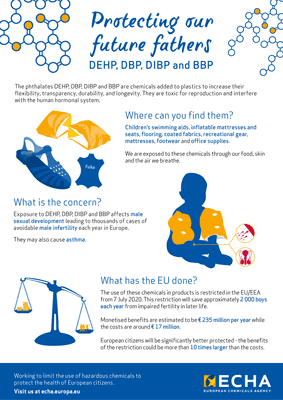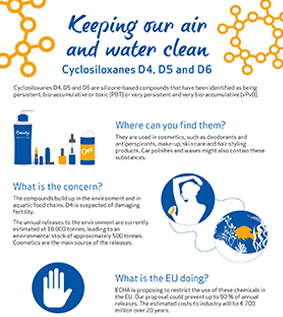How are chemicals controlled?
Life would not exist without chemicals - they are present in us, all around us, and in every product we buy. The European Union has the most ambitious chemicals laws in the world to protect us. Both companies and authorities have a role to play to improve safety.

European Union’s chemicals legislation aims to protect us and the environment from dangerous chemicals. At the same time, it also aims to enhance the competitiveness and innovation of European industry and to promote alternatives to testing chemicals on animals.
The four main pieces of EU chemicals legislation are:
The REACH Regulation: Registration, Evaluation, Authorisation and Restriction of Chemicals
Under REACH, companies need to provide information on the chemicals that they manufacture or import. If a chemical cannot be used safely, authorities can decide on measures to manage its risks.
The Classification, Labelling and Packaging (CLP) Regulation
This law ensures that the hazards of chemicals are clearly communicated to workers and consumers. This happens through labels with standardised statements and pictograms.
The Biocidal Products Regulation (BPR)
Biocidal products, like disinfectants or insect repellents, protect us or various materials against harmful micro-organisms. This law ensures that we have enough information so that consumers can use these products safely.
The Prior Informed Consent (PIC) Regulation
This regulation sets guidelines for the export and import of hazardous chemicals.
In addition, many more laws regulate the use of chemicals. Specific groups of chemicals, such as pesticides, pharmaceuticals or cosmetics, are covered by their own legislation.
Companies have to prove that their chemicals are safe to use
In the EU, companies manufacturing or importing chemicals need to prove that their chemicals are safe to use. They need to register them with the European Chemicals Agency, ECHA, otherwise they cannot sell them in the EU.
Companies must provide information on their chemicals regarding their hazardous properties and how they can be used safely. They also need to inform their customers in the supply chain how the risks posed by their chemicals can be managed. If a chemical cannot be used safely, authorities can restrict its use or make it subject to a prior authorisation. This puts pressure on companies to replace the most hazardous chemicals with safer alternatives.
Companies need to identify any dangerous properties that their chemicals have that could damage human health or the environment. They must classify them as appropriate – for example, as causing cancer or as being toxic for life in rivers and seas. The chemicals also need to be labelled appropriately with the right pictograms and explanations on how to handle them safely.
This way, workers and consumers can understand the effects of chemicals, make informed choices on the products they buy and use them safely.
What does ECHA do?
ECHA manages the information on chemicals that is provided by industry. It publishes information on registered chemicals and on how they are classified and labelled. This data is freely available on ECHA’s website for everybody to see – it is a unique database comprising information on thousands of chemicals used daily in Europe. The website also has information about biocides.
Information on chemicals is screened and the Agency checks, for example, which ones are used widely in a way that consumers or workers may be exposed to them. ECHA evaluates the chemical safety information from industry and requests for more data if important information is missing. Based on the information, ECHA, Member States and the Commission work together to manage the risks posed by dangerous chemicals – this can mean, for example, restricting some or all of their uses. By improving knowledge and raising awareness, the most dangerous chemicals will be gradually replaced by safer ones.
Managing risks of chemicals
Restrictions protect human health and the environment from risks posed by chemicals in the EU. They may limit the manufacture, import, placing on the market or specific uses of a substance. Restrictions can also ban all or specific uses of a substance.


Authorisation
If a substance is identified as particularly harmful to human health or the environment, it will be added to the Candidate List of substances of very high concern (SVHCs). This list is published by ECHA and is regularly updated. If a substance is placed on this list, companies manufacturing, importing or using it have legal obligations. Consumers have the right to ask if certain products they buy contain substances of very high concern that are on the Candidate List above a certain concentration.
If a substance of very high concern gets included in the Authorisation List, it cannot be used or placed on the EU market after a specific date – unless a specific authorisation has been requested and granted. To apply for an authorisation, companies need to perform a detailed analysis of alternatives for the uses of their substance. They have to demonstrate that the risks of using the substance are small. In certain cases, they also need to show that the benefits for society are higher than the risks posed and that there are no suitable alternatives available.
Harmonised classification and labelling
Companies manufacturing, importing or using chemicals need to classify them in line with the identified hazards. They need to label their dangerous substances and mixtures and package them accordingly. For the most dangerous chemicals – for example, those causing cancer – this classification and labelling needs to be harmonised throughout the EU. This ensures that their risks are managed adequately in all Member States.
Who controls companies?
It is the national enforcement authorities who inspect companies and check whether they comply with the law. They can impose fines on companies not fulfilling their duties.
Chemicals - terminology
In these pages, we use the terms “chemicals” and “products”. The legal text has a more specific terminology: substances, mixtures and articles.
- Substance means a chemical element and its compounds in the natural state or obtained by manufacturing. Examples: silver, natrium chloride
- Mixture means a mixture or solution that is composed of two or more substances. Examples: paint, washing powder
- Article means an object which during production is given a special shape, surface or design. This determines its function to a greater degree than does its chemical composition. Examples: t-shirt, hammer
For more information, have a look at ECHA-Term, our multi-lingual terminology database. It has a good collection of definitions relating to chemicals.
